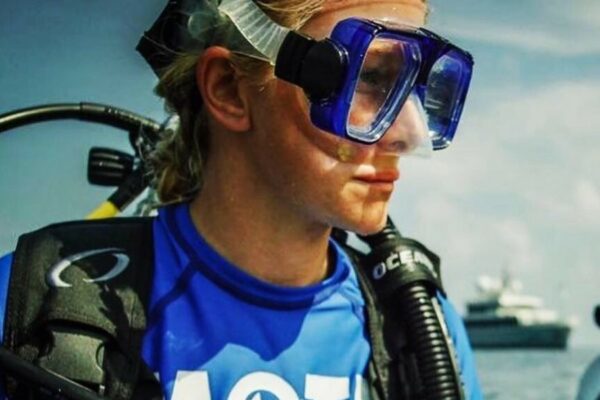
Mountainous Star Coral, the massive species that spawned after being restored by Mote Marine Laboratory. Credit: Joe Berg
via Mote Marine Lab
Sarasota, Florida
For the first time in Florida or Caribbean waters, restored massive corals were observed spawning—part of sexual reproduction that could result in the next generation of coral offspring—thanks to Mote Marine Laboratory & Aquarium’s innovative efforts to restore Florida’s Coral Reef.
Over the past few nights in early August 2020, Mote coral scientists observed restored colonies of Mountainous Star Coral (Orbicella faveolata) on a reef near Cook Island, hoping to capture the brief moment during the evening where the coral release their gametes (eggs and sperm) into the water column. On Aug. 9, to the delight of Mote scientists, a coral colony known to be gravid released its gametes in an extraordinary display. Further cause for underwater celebration came on Aug. 10, when at least eight more colonies spawned. This is the first time that restored massive corals have been documented to spawn on Florida’s Coral Reef.
The documentation of the presence of gametes and of spawning in colonies of restored Mountainous Star Coral is a first for massive corals in Florida and the Caribbean. This key species is listed as threatened under the U.S. Endangered Species Act, and is one of the most critical reef-builders on Florida’s Reef Tract, helping to form the backbone of the entire reef system.

Mote coral reproduction researcher Dr. Hanna Koch. Image: Ocean X.
Corals reach sexual maturity not at a certain age, but a certain size. Growing at less than 1 centimeter per year, mountainous star coral might take decades to reach sexual maturity. Through the Mote-pioneered methodology of microfragmentation-fusion, these slow-growing corals can have their growth process sped up significantly, with these corals reaching sexual maturity in just five years.
Mote’s science-based coral restoration strategy not only creates viable colonies of coral at an accelerated rate, but also concentrates on genetic varieties (genotypes) of corals that are resistant to common stressors found in the ocean environment. These mountainous star coral colonies have endured a global bleaching event in 2015, a Category-4 hurricane (Irma) in 2017, and the 2019 outbreak at this site of stony coral tissue loss disease, which has affected millions of reef corals across Florida’s Coral Reef and beyond.
This August, Dr. Hanna Koch, accompanied by other Mote scientists and interns, is leading three field research efforts focused on spawning: documenting spawning activity from the restored mountainous star coral (O. faveolata) near Big Pine Key and restored staghorn coral (A. cervicornis) near Key West, while collecting sperm and eggs from elkhorn coral (Acropora palmata) at Looe Key for reproduction events back at Mote’s Summerland Key campus.
Source
Mote Marine Lab
August 12, 2020
https://mote.org/news/article/breakthrough-restored-corals-ready-to-become-parents
Mote’s research and restoration activities described above were permitted by NOAA’s Florida Keys National Marine Sanctuary (FKNMS-2018-088-A2 & FKNMS-2015-163-A3).





Aware of the Pacific Cook Islands but where is Cook Island in the Caribbean?
Just south of big pine key.